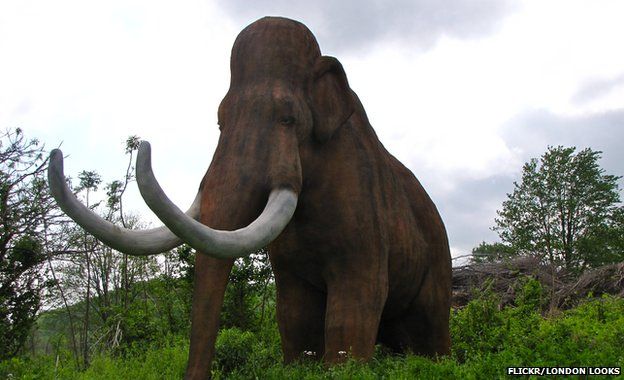- 23 April 2015
- Science & Environment

An international team of scientists has sequenced the complete genome of the woolly mammoth.
A US team is already attempting to study the animals' characteristics by inserting mammoth genes into elephant stem cells.
They want to find out what made the mammoths different from their modern relatives and how their adaptations helped them survive the ice ages.
The new genome study has been published in the Journal Current Biology.
Dr Love Dalén at the Swedish Museum of Natural History in Stockholm told BBC News that the first ever publication of the full DNA sequence of the mammoth could help those trying to bring the creature back to life.
"It would be a lot of fun (in principle) to see a living mammoth to see how it behaves and how it moves," he said.
But he would rather his research was not used to this end.
"It seems to me that trying this out might lead to suffering for female elephants and that would not be ethically justifiable."
Dr Dalén and the international group of researchers he is collaborating with is not attempting to resurrect the mammoth. But the Long Now Foundation, an organisation based in San Francisco, claims that it is.
Now, with the publication is the complete mammoth genome, it could be a step closer to achieving its aim.
On its website the foundation says its ultimate goal is "to produce new mammoths that are capable of repopulating the vast tracts of tundra and boreal forest in Eurasia and North America.
"The goal is not to make perfect copies of extinct woolly mammoths, but to focus on the mammoth adaptations needed for Asian elephants to live in the cold climate of the tundra.
"The milestones along the way range from developing elephant tissue cultures to genome editing and cloning".

The foundation is supporting a team based at Harvard University which is using genetic engineering techniques to insert mammoth genes into living elephant cells.
So far, the foundation says it has placed mammoth genes involved in blood, fat and hair into elephant stem cells in order to study the effects of these genes.
The researchers hope to produce mammoth red blood cells to see how much oxygen they might have carried and so learn more about the physiology of the animals. Similar tests, they claim, can be done to investigate how their fat and hair grew.
The Long Now Foundation's stated aim is to insert synthetically-created mammoth genetic material inside an elephant egg, which they would then place in a zoo elephant. It believes that cloning attempts can begin by 2018.
Many experts, however, believe that there are considerable obstacles in the way of creating a mammoth in this way. Among them is Prof Beth Shapiro of the University of California, Santa Cruz, who has written a book called How to Clone a Mammoth.
"There is an enormous difference between a having cell living in a dish in a lab whose genome contains a few changes and having a living animal that is a little bit mammoth-like," she told BBC News.
De-extinction
"We'd have to use that cell to create an embryo, get an embryo into a maternal host, and establish a pregnancy and hope that pregnancy was successful."
Prof Shapiro is opposed to what is known in the field as "mammoth de-extinction".
"Elephants do not fare well in captivity, struggle with assisted reproduction, and should be allowed to make more elephants.
"Secondly, elephants are highly social creatures and there is no reason to suspect that mammoths were not. One mammoth would be necessarily alone in the world. It could not be released into the freedom of the Arctic until there were many of them. Until we can make many mammoths without using elephants, to my mind it is ethically unsound."
Dr Dalén and his colleagues sequenced the mammoth genome in order to learn more about what happened when the creature went extinct around 4,000 years ago on Russia's Wrangel Island.
They compared the DNA of one of the last creatures to have lived with one that lived 45,000 years ago when mammoths were more commonplace.
The study showed that that the population on Wrangel Island was so small that the animals became inbred for the last 5,000 years of their existence. Dr Dalén can't say categorically that inbreeding was the cause or contributed to their eventual demise because it doesn't always have a negative effect, but he says that his study makes this a distinct possibility.
"When we look at modern animals we know that most animals that are inbred suffer from it. So we think it is likely that it had some sort of negative effect," he said.
The genetic data also showed that there was a dip in the mammoth population 300,000 years ago.
"We were very surprised by this," Dr Dalén said. "It seems like there was an ancient bottleneck. It was before modern humans were in this region and we are not entirely sure what caused it. A good bet is that it was due to a past change in climate."
Prof Shapiro believes that there is much more to come from the new mammoth DNA.
"We'll probably find answers to questions that we've yet to think of. Genomes are rich sources of information, and we have only tapped the surface of that information," he said.
No comments:
Post a Comment